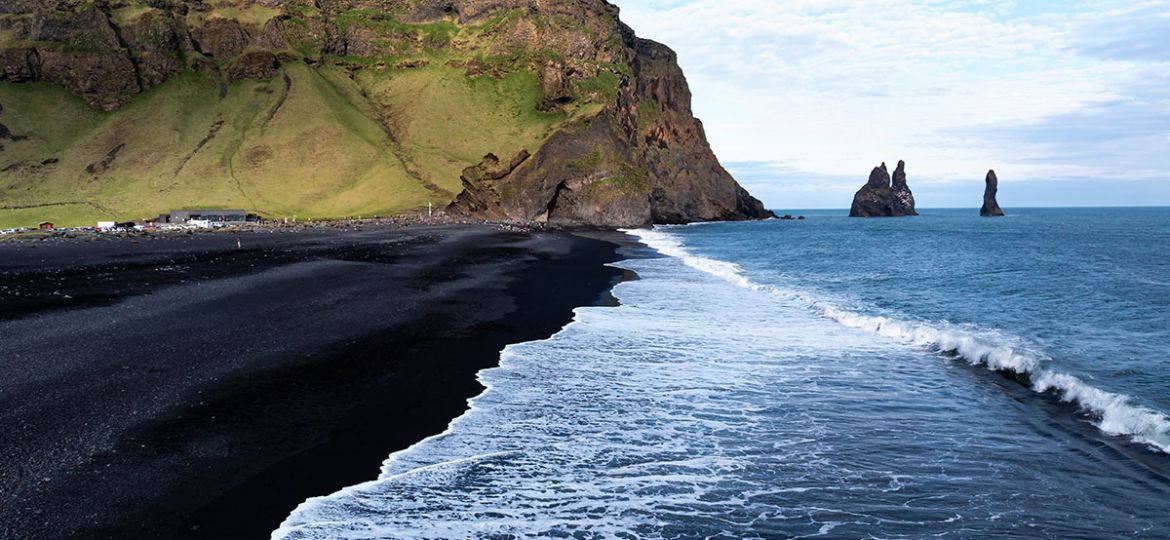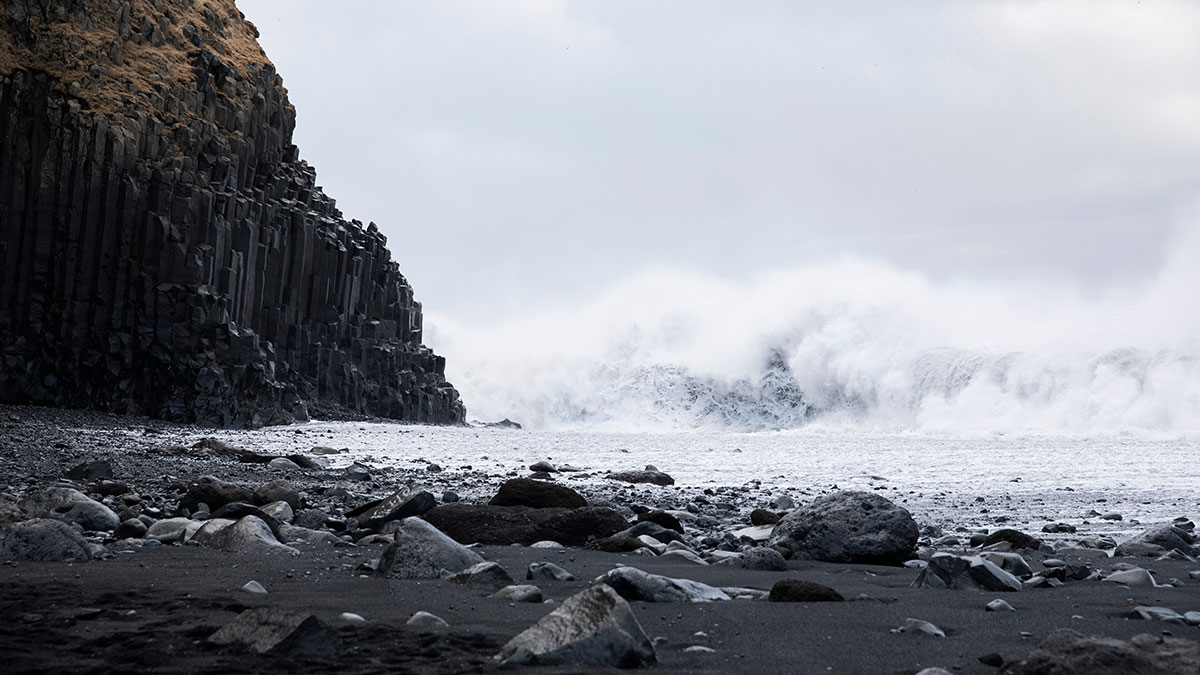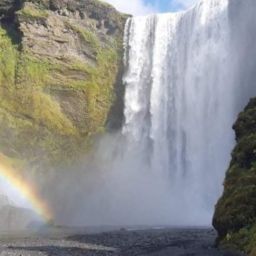
Reynisfjara is breathtakingly beautiful, even by Iceland’s very high standards. Unsurprisingly, that makes this swath of black sand one of the country’s most visited beaches, yet it’s also one of its most notorious. In this article we’ll take a look at this popular south coast beach, exploring what makes it a must-see for visitors but also why it’s often a hazardous place to visit. However through our practical advice and safety tips, we’ll demonstrate why you shouldn’t leave Reynisfjara off your South Iceland itinerary.
What and where is Reynisfjara?
Reynisfjara is a black sand beach located just a few miles west of the village of Vik. Easily accessible from Iceland’s ring road, it’s no surprise that the majority of travellers heading along the country’s south coast towards Fjallsárlón and Jökulsárlón Glacier Lagoon make a pit stop here. This stretch of black sand is especially photogenic thanks to the presence of towering basalt columns that flank a large cave at the back of the beach and the view of the Reynisdrangar sea stacks just offshore.
To understand why there’s a basalt cave behind the beach, we need to look to the past. Geological studies have focused on a volcanic eruption that took place about three million years ago. Magma flowed out of the earth, forming Mount Reynisfjall in the process, and as it travelled over the land, it cooled.
When basalt changes temperature like this, it contracts and cracks. In doing so, it has created the characteristic hexagonal shape of these columns – keep your eyes peeled and you’ll see that you’ll encounter similar landforms in many other places in Iceland. Here, these basalt columns have formed a spectacular landform named Hálsanefshellir cave. The reason the beach is a dark charcoal colour too is that the basalt rock has been eroded into tiny grains of sand.
Reynisdrangar
The craggy sea stacks that sit just offshore are an easily recognisable landmark. These pillars of rock stand 66 metres high, so they’re visible no matter whether the tide is in or out. Their presence here is linked to Mount Reynisfjall, located just opposite on the mainland. Geologists believe that this peak was created during that same ancient volcanic eruption several million years ago.
During that eruptive phase, lava would have flowed out from a fissure in the earth’s crust, over the cliff and out to sea. As with the formation of the cave, basalt would have solidified into lumps out in the ocean as the superheated rock came into contact with the much colder water.
Over the intervening period, the action of the waves has sculpted the basalt into the jagged rocks that we see today. Hydraulic action – the process whereby air is forced into tiny gaps and cracks in the rock – has caused chunks to fall off, while material carried by the waves has also abraded the surface of the sea stacks.
What’s the danger?
There’s an element of danger to a visit to Reynisfjara which has led to it developing a reputation as being one of the most notorious beaches in the whole of Iceland. To learn why, we have to take a look at the geography. The south coast of Iceland faces the North Atlantic and there’s a vast expanse of ocean between it and the next land mass.

When waves travel across large areas of open water and have a long fetch, they are able to pick up strength. But not every wave will be as powerful as the one before it and it’s this variation and lack of pattern that makes these waves so unpredictable. Even on a fine, calm day so-called sneaker waves can creep up to the shore unexpectedly. These waves are unexpectedly large and travel a long way up the beach without warning.
Should you visit Reynisfjara?
Waves such as this are powerful enough to sweep a person off their feet. On a windy day especially, this beach is therefore a dangerous place to turn your back on the ocean – though of course that’s not something you should ever do no matter what the conditions. Cold water and strong currents close to shore mean that once a person is in the water it’s very difficult for them to right themselves and get to a safer place higher up on the beach. It’s also far too dangerous for others to enter the water to try to rescue them.

Sadly, there have been fatalities on this beach as a result. As a consequence, a traffic light system has been introduced for the beach. Basically, the beach area has been divided into different zones. When the light is red, stay right back off the beach. As it’s pounded by large waves, nowhere on the beach is considered safe so you’ll have to content yourself with the view from a distance.
When the light is amber, proceed with caution. Take a look at the plan of the beach that’s clearly marked on the information board and, no matter what others may be doing, stay right away from the area marked as the yellow zone. Note that it’s never safe to enter the waves or to attempt to walk around the headland even at low tide. If the light is green, you should be fine to be on the main part of the beach – though keep an eye on the ocean at all times even so and never underestimate what it’s capable of.
Preparing to visit Reynisfjara
It’s a good idea to check the weather forecast to see what the wind speeds are likely to be and also take a look at the tide timetables to find out if your visit will coincide with high or low tide. Wear sturdy shoes that have ankle support and dress in layers appropriate for the temperature on the day.
Remember, so long as you heed the warnings, you shouldn’t feel you need to stay away and miss out on that spectacular view. But safety has to be your priority – no place, no matter how incredible it looks or how long you have yearned to see it, is worth risking your life for. You can always come back another day.
Getting to Reynisfjara
This world-class beach is located approximately midway between the capital region and the glacial lagoons at Fjallsárlón and Jökulsárlón. It’s a drive of about two and a half hours in either direction. Tourists making their way along the south coast as part of a road trip often schedule a stop in nearby Vik where there are many fun activities to do along this stretch of the coastline or up on Mýrdalsjökull glacier.

But even if you are only passing through, a stop at Reynisfjara beach is almost obligatory. Just before the ring road drops down into Vik itself, you’ll see a marked turn off leading to Reynisfjara. Follow the road for a short distance and you’ll find a small car park, from where its a short stroll to the beach itself.
You’ll pass those traffic lights we mentioned, along with an information board that explains the hazards. It’s worth taking a moment to read this sign to remind yourself about how to stay safe before – hopefully – conditions allow you to continue onto the beach. Scan the beach from this point and familiarise yourself with those all-important zones before setting foot on the sand.
Reynisfjara is one of Iceland’s most famous beaches for a reason and you won’t want to miss it, but we’d urge you to be extremely careful while you’re there.


